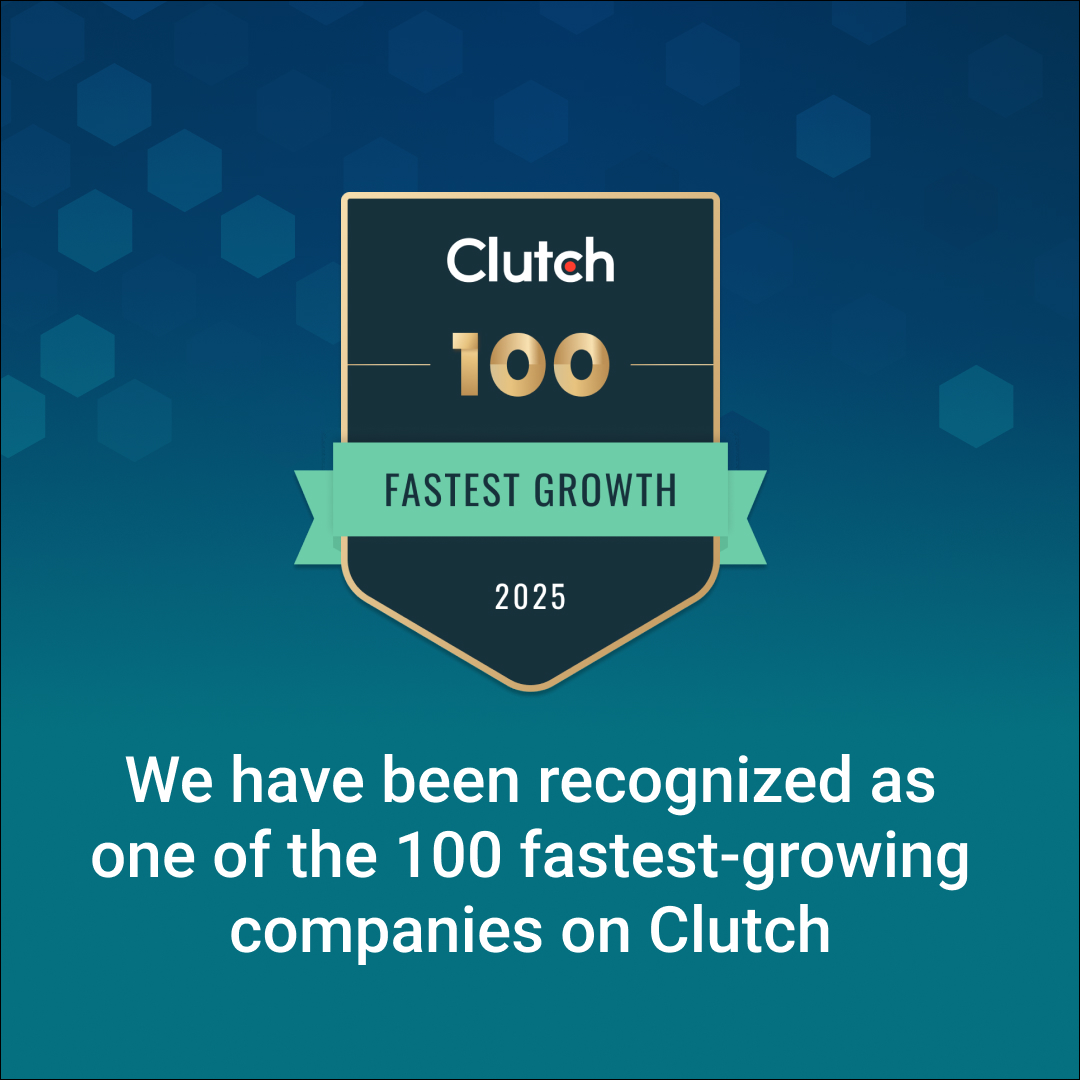Introduction
The mobility industry is undergoing a once-in-a-century transformation, driven by rising urban populations, mounting environmental pressures, and shifting consumer expectations for seamless, personalized transportation. Traditional models—dependent on fixed schedules, human drivers, and static infrastructure—are straining to keep pace.
Artificial Intelligence (AI) is emerging as a powerful enabler, reshaping mobility through real-time decision-making, predictive insights, and automation. From autonomous vehicles to demand-responsive transit systems, AI is delivering solutions that optimize traffic flow, enhance passenger safety, and reduce emissions. This guide explores how AI is redefining mobility, backed by real-world use cases and practical insights for industry leaders.
What is AI and Why Does It Matter in Mobility?
 Definition of AI and Its Core Technologies
Definition of AI and Its Core Technologies
Artificial Intelligence (AI) refers to the development of computer systems capable of performing tasks that typically require human intelligence, such as perception, decision-making, and problem-solving. Core technologies include machine learning, natural language processing (NLP), and computer vision, which enable machines to learn from data, interpret human language, and understand visual inputs.
In mobility, AI applies these capabilities to dynamic transport environments—processing massive streams of sensor, traffic, and user data in real time. This allows systems to adapt instantly to changing conditions, whether predicting congestion, rerouting vehicles, or managing shared fleet operations.
Want to explore how AI can transform your sector? Discover real-world strategies for deploying smart technologies in mobility. Visit How to Integrate AI into Your Business in 2025 to get started today and unlock the full potential of AI for your business!
The Growing Role of AI in Transforming Mobility
AI is enhancing operational efficiency in mobility by enabling intelligent traffic management systems. These platforms analyze live data from road sensors and connected vehicles to predict congestion patterns and adjust signal timing, reducing delays and improving flow.
In public transportation, AI powers demand-responsive transit, adjusting routes and schedules based on passenger needs rather than fixed timetables. This not only cuts operational costs but also improves service quality for underserved areas.
Autonomous driving represents the most visible AI application, where perception algorithms, path planning, and decision-making models work together to navigate complex road scenarios safely. These systems are gradually transitioning from controlled pilots to large-scale deployment, promising to transform both passenger and freight transport.
Key Statistics or Trends in AI Adoption
The global AI in transportation market was valued at $3.5 billion in 2023 and is projected to reach $14.79 billion by 2030, growing at a CAGR of 23.1%. This surge is fueled by increased investment in autonomous driving and smart infrastructure.
McKinsey estimates that AI-enabled traffic management could reduce travel times in urban areas by up to 20%, significantly cutting emissions and boosting productivity.
According to Statista, over 55% of leading mobility companies have already deployed AI for fleet optimization, with adoption rates expected to exceed 80% by 2027.
Business Benefits of AI in Mobility
1. Reduced Traffic Congestion and Improved Flow
Congestion is one of the most persistent urban challenges, costing cities billions in lost productivity and fuel. Traditional traffic control relies on fixed schedules that can’t adapt to real-time fluctuations. AI-powered adaptive traffic management systems ingest live data from road sensors, cameras, and connected vehicles, then adjust signal timings dynamically. This creates smoother flow, reduces stop-and-go driving, and improves travel predictability.
In Pittsburgh, an AI traffic light system reduced travel times by 25% and idling time by 40%, cutting emissions significantly. Scaling similar deployments across major metros could save commuters hours annually while reducing municipal energy use.
2. Predictive Fleet Maintenance and Reliability
Fleet operators—from public buses to logistics trucks—face high costs and service disruptions from unplanned breakdowns. AI-enabled predictive maintenance uses telematics, sensor data, and historical repair logs to forecast component failures before they occur. This proactive approach schedules maintenance during low-demand windows, keeping assets in operation.
Penske Truck Leasing’s AI system processes 300 million data points daily to predict faults, reducing downtime and improving fuel efficiency. Clients report better asset utilization and lower repair costs, proving that predictive maintenance is not just operationally sound but financially transformative.
3. Safer Driving via Driver Monitoring
Human error causes over 90% of traffic accidents, and driver fatigue or distraction is a major contributor. AI-driven Driver Monitoring Systems (DMS) use computer vision to detect microsleeps, gaze direction, and posture, issuing real-time alerts. These systems integrate with vehicle controls to apply corrective measures when necessary.
Smart Eye’s DMS, deployed in over one million vehicles, has been credited with preventing countless accidents in commercial fleets and luxury cars alike. The EU’s new General Safety Regulation mandates such tech in all new cars from 2024—signaling both market growth and societal impact.
4. Autonomous Mobility on Demand (AMoD)
Static public transport schedules can’t always meet fluctuating demand. AI-enabled AMoD services operate fleets of autonomous vehicles that reposition themselves based on predictive demand models, ensuring availability where and when needed. This improves accessibility and reduces reliance on private vehicles.
Baidu’s Apollo Go robotaxi service in Wuhan has completed over 7 million rides with zero major accidents, supported by AI-driven fleet balancing and route optimization. Such systems offer a blueprint for congestion-free, high-efficiency urban mobility.
5. Data-Driven Infrastructure Planning
Mobility projects often require years of planning and huge capital commitments, yet poor forecasting can undermine ROI. AI models simulate the impact of road expansions, EV charging placement, or new bus routes before ground is broken
Google’s Mobility AI enables agencies to model scenarios in minutes, comparing congestion, coverage, and environmental outcomes. This allows decision-makers to select investments with the highest net benefit, cutting waste and accelerating project timelines.
Challenges Facing AI Adoption in Mobility
1. Fragmented and Low-Quality Data
AI thrives on clean, unified datasets. In mobility, information is often scattered across traffic control systems, vehicle OEMs, ride-hailing platforms, and municipal databases—each with different formats and quality standards. This fragmentation prevents AI from forming a complete picture.
Without integration, predictive models can produce unreliable outputs, leading to operational inefficiencies. Cities like Singapore have addressed this by building centralized mobility data platforms, but many regions still lag behind, making data readiness a critical first step.
Siloed systems and scattered data can cripple decision-making and slow growth. Discover how AI is helping organizations unify, clean, and unlock value from their data faster and smarter. Explore the full article to see how AI transforms data chaos into clarity.
2. High Implementation Costs
Deploying AI in mobility—whether for autonomous fleets or city-wide traffic control—requires upfront investments in sensors, connectivity, and computing infrastructure. For smaller municipalities or fleet operators, these costs can be prohibitive.
However, cloud-based AI services and public-private partnerships are helping offset capital expenses. For example, Los Angeles’ ATSAC traffic management upgrades were partially funded through infrastructure grants, making AI more accessible for public use cases.
3. Regulatory and Safety Compliance
Mobility AI operates in heavily regulated domains where safety is paramount. Autonomous driving systems must pass extensive trials before approval, which can vary by jurisdiction and delay rollouts
In Europe, UNECE regulations require continuous driver supervision in most current systems, slowing the path to full autonomy. Developers must navigate a patchwork of rules while proving safety through transparent reporting and third-party validation.
4. Cybersecurity and Privacy Risks
Connected mobility platforms create new attack surfaces. If compromised, hackers could access vehicle controls, disrupt traffic systems, or leak sensitive location data. This makes cybersecurity a non-negotiable investment for AI adoption.
In 2022, a researcher remotely accessed Tesla’s in-car systems via a third-party vulnerability—though without causing harm, it underscored the need for robust, continuously updated defenses.
5. Public Trust and Acceptance
Even if AI meets safety and efficiency benchmarks, public perception can slow adoption. Fear of machine error, privacy concerns, and unfamiliarity with autonomous systems can limit usage.
Pilot programs that allow gradual exposure—such as supervised robotaxi trials—help build confidence. Baidu’s strategy of operating in geofenced, low-risk environments before expanding citywide has shown how careful rollout can turn skepticism into support.
For those navigating these complex waters, a business-oriented guide to responsible AI and ethics offers practical insights on deploying AI responsibly and transparently, especially when public trust is at stake.
Specific Applications of AI in Mobility
This section outlines six impactful AI applications redefining mobility. Each solution addresses a critical industry challenge and offers measurable value.
 Use case 1. Autonomous Vehicles for Shuttle Services
Use case 1. Autonomous Vehicles for Shuttle Services
Autonomous shuttle services tackle last‑mile transit gaps in urban and campus settings by providing on‑demand, driver‑free rides. These systems use computer vision and sensor fusion—leveraging LiDAR, radar, and cameras—to interpret surroundings and navigate safely. They integrate into transport networks via ride‑booking apps and route optimization systems.
AI enables dynamic decision‑making, significantly reducing wait times and improving accessibility and service frequency. Scalability depends on robust sensor calibration and edge‑processing capacity, and ethical considerations include passenger safety under unpredictable conditions. Ensuring fail‑safe operation and cybersecurity is essential given the operational environment.
Real-World Example
Mozee, a Dallas‑based autonomous transportation company, deploys electric multi‑passenger shuttles using computer vision and sensor fusion to bridge first‑mile/last‑mile gaps on campuses and in communities. Their AI‑driven vehicles offer ride booking and route updates via a mobile app, enhancing accessibility and sustainability. This deployment reduces congestion and carbon emissions while improving commuter convenience.
Use case 2. Predictive Fleet Maintenance Using Telematics
Predictive maintenance uses AI to anticipate vehicle failures before breakdowns occur, minimizing downtime and repair costs. It relies on telematics and real‑time sensor data—such as engine diagnostics and tire conditions—analyzed through machine learning models. These insights feed into fleet management systems, triggering proactive interventions.
Operational value includes improved uptime, reduced maintenance costs, and longer asset lifecycles. However, integrating vast data requires scalable infrastructure and may raise data privacy concerns. The accuracy of models hinges on quality and comprehensiveness of historical maintenance data.
Real-World Example
Penske Truck Leasing employs its Catalyst AI platform, ingesting 300 million data points a day from telematics devices to detect impending mechanical issues across its 433,000‑truck fleet. The system enables early intervention, enhancing fuel efficiency and preventive maintenance benchmarking. Clients like Honeyville report significantly reduced response times and improved fleet performance.
Use case 3. Smart Traffic Enforcement with AI-Enabled Cameras
AI‑powered cameras automate detection of traffic violations—such as illegal parking and wrong‑side driving—without manual enforcement. Video feeds are processed in real time using computer vision models trained to recognize predefined infractions. The system integrates with municipal enforcement platforms to issue citations automatically.
This reduces manual surveillance, enhances compliance, and eases congestion. Yet, accuracy must be ensured to avoid misidentification, and systems must respect privacy and data retention regulations. Responsible deployment mandates transparency and safeguarding of citizens’ rights.
Real-World Example
In Pune, India, AI‑enabled cameras recorded 3,982 traffic violations, including no‑parking, double parking, and mobile phone use, entirely through automated detection since May 28, 2025. Only 1% of offenders were repeat violators, indicating improved discipline and traffic flow. The system removed the need for human oversight in enforcement.
Use case 4. In-Cabin Driver Monitoring Systems (DMS)
Driver Monitoring Systems use AI to detect driver drowsiness, distraction, and unsafe behaviors by analyzing gaze, head movement, and posture via in‑car cameras. Computer vision and deep learning models interpret real‑time video feeds without storing sensitive footage. Alerts are triggered immediately, assisting driver safety while integrating with vehicle control systems.
This enhances road safety by preventing accidents due to human factors and supports compliance with emerging safety regulations. Challenges include ensuring data privacy, avoiding bias in model training, and ensuring consistent performance across driver demographics. The technology must be resilient to lighting conditions and driver variability.
Real-World Example
Smart Eye’s AI‑powered DMS is integrated into over one million vehicles globally, using deep learning and synthetic data to monitor driver behavior without recording video. It complies with EU mandates for distraction monitoring and supports OEMs like BMW and Polestar. The system enhances safety while respecting privacy.
Use case 5. Vision-Based End-to-End Autonomous Driving
End‑to‑end vision‑based AI systems train neural networks to map visual input directly to driving actions, reducing reliance on high‑definition maps. They use vast datasets—such as driving videos—to learn driving behavior through supervised and reinforcement learning. These models run onboard and integrate with vehicle controls for steering, acceleration, and braking.
This simplifies infrastructure requirements and improves adaptability to new environments. However, it demands massive, varied training data and poses challenges in explainability and model safety. Simulating long-tail edge cases remains crucial for ensuring reliability.
Real-World Example
Wayve, a European firm, uses a purely end‑to‑end AI-driven driving system based exclusively on camera input without high‑definition maps. Their models learn from large volumes of unlabelled driving video, enabling adaptability to diverse scenarios. Backed by Softbank, Microsoft, and Nvidia, Wayve is partnering with automakers to integrate its technology into advanced driver assistance systems.
Use case 6. Autonomous Robotaxi Fleets
Robotaxis offer fully driverless ride‑hailing services, operating on-demand without onboard safety personnel. They deploy combinations of LiDAR, radar, cameras, and AI algorithms—including behavior prediction and multi-policy decision making—to navigate complex urban environments. These systems connect with mobility platforms, enabling seamless user access and fleet management.
Robotaxis can reduce transport costs, broaden access, and optimize fleet efficiency. Regulatory, safety, and public trust remain key challenges; and scalability requires robust mapping, simulation, and continuous monitoring. Maintaining ethical standards and mitigating liability are critical.
Real-World Example
Baidu’s Apollo Go operates over 400 fully autonomous robotaxis in Wuhan, providing 24/7 service and completing 7 million rides by mid‑2024, with over 100 million kilometers driven without major accidents. Their sixth‑gen platform costs under $30,000, aiming for operational breakeven. This demonstrates scalable, safe, and cost‑effective robotaxi deployment.
Need Expert Help Turning Ideas Into Scalable Products?
Partner with SmartDev to accelerate your software development journey — from MVPs to enterprise systems.
Book a free consultation with our tech experts today.
Let’s Build TogetherExamples of AI in Mobility
The practical applications described earlier demonstrate AI’s transformative potential. Below are data-driven case studies showing real-world outcomes and emerging innovations that push the boundaries of mobility.
Real-World Case Studies
 Baidu Apollo Go: Scalable Robotaxi Service
Baidu Apollo Go: Scalable Robotaxi Service
Baidu’s Apollo Go program in Wuhan represents one of the largest operational deployments of fully driverless robotaxis in the world. With over 400 autonomous vehicles serving residents 24/7, the service reached 7 million cumulative rides by mid-2024, covering more than 100 million autonomous kilometers without a major accident. Such scale is possible thanks to Baidu’s sixth-generation autonomous platform, which brings hardware costs down to under $30,000 per vehicle—drastically reducing the cost barrier for future expansion.
The implications are significant: Apollo Go is not just proving the technical feasibility of driverless fleets, it’s showing that fully autonomous mobility can achieve public trust and operational reliability at scale. By combining cost-efficient hardware with AI-driven fleet orchestration, Baidu has created a blueprint for cities aiming to reduce congestion, expand transit access, and improve sustainability through shared autonomous services.
Penske Fleet Insight: Predictive Maintenance in Action
Penske Truck Leasing’s Catalyst AI platform processes more than 300 million telematics data points daily from its fleet of over 430,000 trucks. The system uses machine learning models to predict potential mechanical issues before they escalate into costly failures. By proactively scheduling repairs and part replacements, Penske reduces unplanned downtime, optimizes fuel efficiency, and extends vehicle lifespans.
The value is not only operational but also customer-facing. Clients like Honeyville report faster response times and improved delivery reliability—critical in industries where even small delays can ripple across supply chains. Penske’s results illustrate how predictive AI maintenance can transform fleet economics, shifting maintenance from a reactive cost center into a proactive value driver, and positioning AI as a core component of logistics competitiveness.
Mozee Autonomous Shuttles: Sustainable Last-Mile Mobility
Mozee’s fleet of electric autonomous shuttles is designed to solve the “last-mile” challenge—bridging the gap between transit hubs and final destinations. Equipped with advanced LiDAR, computer vision, and AI navigation systems, these shuttles operate in controlled environments such as university campuses and mixed-use urban zones. They provide on-demand, zero-emission transport that reduces reliance on private cars and helps ease congestion in dense areas.
Deployed in Dallas and planned for service during the 2026 FIFA World Cup, Mozee’s model demonstrates how localized, AI-driven mobility can scale to meet major event and community needs. The service’s flexibility and environmental benefits make it a compelling case for cities seeking sustainable transit solutions that can adapt quickly to fluctuating demand without significant infrastructure overhauls.
These examples reflect the value of working with technology partners who understand both the technical and policy implications. If you’re considering a similar digital transformation, don’t hesitate to connect with AI implementation experts to explore what’s possible in your context.
Innovative AI Solutions
Beyond present deployments, emerging technologies are shaping the future of AI in mobility.
AI is extending into in‑cab interior sensing, where systems gauge occupant mood, health signs, and comfort needs to personalize the ride experience. Smart Eye’s innovations in interior sensing—with heart and respiration monitoring—hint at intelligent, adaptive cabins.
Generative AI is starting to enrich in‑vehicle virtual assistants for conversational navigation and e‑commerce. Mercedes‑Benz has integrated Google Cloud’s Automotive AI Agent into new vehicles, enabling intuitive voice‑based search, navigation, and sales interactions.
Looking forward, AI‑enabled infrastructure, such as smart traffic corridors and integrated hazard detection, is redefining mobility systems. Projects like Cavnue’s freight‑corridor upgrades and Nexar‑powered hazard alerts exemplify how AI will enhance safety and flow on public roads.
AI-Driven Innovations Transforming Mobility
Emerging Technologies in AI for Mobility
You’re seeing the mobility industry pivot on a spectrum from mechanistic operations to intelligent orchestration—powered by generative AI and computer vision. Generative AI, once confined to content creation, now simulates traffic patterns, models infrastructure scenarios, and tests route efficiencies in synthetic environments. Imagine refining a city’s entire transit scheme virtually, reshaping it before a single lane changes—this is not narrative, but today’s capability.
Alongside that, computer vision systems have become indispensable sentinels on the streets and in vehicles. Cameras read traffic flow, flag hazards, monitor pedestrian behavior, and feed that real-time insight into autonomous systems. These systems sharpen reaction times and enhance safety across dynamic environments. In doing so, you gain situational intelligence—turning infrastructure into a living, responsive network, enabling predictive navigation rather than merely reactive control.
By bringing simulation and recognition into real-world mobility, AI is no longer experimental; it is embedded. You don’t just automate—you architect mobility with foresight and precision.
AI’s Role in Sustainability Efforts
As you endeavor to marry transportation with sustainability, AI emerges not just as a tool but as an accelerator. Predictive analytics now sync vehicle deployment with real-time demand, sparing idle mileage and cutting unnecessary emissions. This precision allows you to reduce operational waste while promoting ecological responsibility—demonstrating that green goals and business performance can align, not conflict.
Meanwhile, smart energy management systems powered by AI orchestrate electric vehicle (EV) charging around grid availability and renewable generation. Charging when solar output peaks or demand ebbs helps lower operational costs and stabilize energy demand cycles. AI transforms EV charging from necessity to strategic enabler—aligning infrastructure efficiency with environmental stewardship.
In essence, AI weaves sustainability into the operational fabric of mobility—letting you do right by the planet while improving your bottom line.
How to Implement AI in Mobility
 Step 1: Assessing Readiness for AI Adoption
Step 1: Assessing Readiness for AI Adoption
Starting any AI journey begins with clarity. You need to identify areas where AI adds functionally measurable value—be it reducing traffic bottlenecks, predictive maintenance in fleets, or optimizing shared vehicle utilization. Simultaneously, you must evaluate your organizational data maturity: do you have high-quality, structured data, or are you wrestling with siloed, fragmented repositories?
Beyond data, readiness is also cultural. A shared vision across C-suite and operational teams, willingness to pivot workflows, and appetite for experimentation form the backbone of successful AI adoption. If your organization isn’t aligned with AI as augmentation rather than threat, pilot projects may stall before they begin.
You don’t just need a smart idea—you need a prepared organization. That’s where transformation starts.
Step 2: Building a Strong Data Foundation
The true ballast for AI success is a robust and governable data infrastructure. Raw data from sensors or logs has little value if inconsistently formatted or poorly managed. You must invest in pipelines that ensure cleanliness, labeling, and standardized governance—turning fragmented inputs into reliable insight.
Moreover, collaboration across IT, operations, and analytics teams is vital to ensure that data pipelines are resilient and adaptive. With structured data architecture, you’re not piecing together cobbled reports—you’re feeding an engine of continuous learning and improvement.
This foundation transforms noise into signal, enabling AI to deliver actionable outcomes with integrity and trust.
Step 3: Choosing the Right Tools and Vendors
Not all AI platforms are created equal. You require solutions honed for mobility—whether that’s real-time route management, autonomous control stacks, or energy optimization interfaces—not generic enterprise software. Look for vendors with proven scale and integration success in urban infrastructure or fleet management.
Equally important: ensure clarity around data ownership, scalability, and adaptability. A platform that locks you into legacy protocols, or hides algorithms from scrutiny, may compromise long-term agility. What you want is a partner that respects your strategic direction, supplements your strengths, and evolves with your goals.
Such alignment turns your vendor from an outside supplier into a strategic ally.
Step 4: Pilot Testing and Scaling Up
Begin with a focused, narrow pilot—whether it’s optimizing shuttle routes, automating parking enforcement, or testing predictive alerts in fleet maintenance. A well-designed pilot surfaces integration challenges, clarifies employer benefits, and offers defensible ROI metrics before a broader rollout.
For instance, Waymo’s robotaxi units now complete more daily trips per vehicle than 99% of Uber’s human-driven fleet in comparable environments—showing that scaling can translate into utilization gains and tangible revenue impact Wall Street Journal.
Once your pilot is validated, scale in phases—widen geographies, diversify use cases, refine based on learning—but do so with measurement, iteration, and steadfast focus on business outcomes.
Step 5: Training Teams for Successful Implementation
AI systems only succeed when your people trust and understand them. Provide practical training—explain not just dashboards, but how insights translate into action and strategy. Identify and empower internal AI champions who interpret results, bridge technology and operations, and ensure sustainable adoption.
When teams feel ownership, not confusion, AI transforms from novelty to normal—a trusted instrument rather than an alien intrusion.
Whether you’re exploring your first pilot or scaling an enterprise-wide solution, our team is here to help. Get in touch with SmartDev and let’s turn your supply chain challenges into opportunities.
Measuring the ROI of AI in Mobility
Key Metrics to Track Success
To demonstrate value, metrics must be relevant, measurable, and tied to operational outcomes. Track indicators like decreased idle time, enhanced fleet utilization, efficiency gains, fewer incidents, or energy cost savings. These aren’t academic figures—they’re financial counters that speak to cost reduction, safety improvement, and service reliability.
Concrete, recurring metrics turn AI from idea into insight. They create a feedback loop that aligns your AI deployment with real-world results—and demonstrates unequivocally that investment delivers value.
Case Studies Demonstrating ROI
Uber Freight leverages AI-driven algorithms to optimize truck routing and reduce empty miles—38% of U.S. trucks previously ran empty, fueling inefficiency. Through AI-matching of freight with return routes, the platform has cut empty miles by 10–15%, improving fuel savings and lowering costs. Clients spanning more than 200 Fortune 500 companies have adopted the service, which also reduced customer service wait times from five minutes to just 30 seconds.
Ford introduced AI-powered vision systems—AiTriz and MAIVS—to detect minute assembly misalignments and installation defects at scale. These systems address recurring recall issues—Ford has led U.S. automotive recalls for four of the past five years, with 94 in 2025 alone. By catching defects early, Ford saves potentially hundreds of millions of dollars and enhances production accuracy—and despite the complexity, the systems augment rather than replace human operators.
Pony AI, a robotaxi firm, slashed hardware costs by 70%, bringing the unit cost per autonomous driving system from $137,217 to roughly $41,165—pushing the company closer to breakeven. With mass production slated for mid-2025 and a fleet expansion plan to over 1,000 vehicles, analysts anticipate return on investment may materialize by year-end, positioning Pony AI as a compelling business case in autonomous mobility.
These real-world examples illuminate how AI is not speculative—it’s a measurable financial and operational asset when applied wisely.
Understanding ROI is possibly a challenge to many businesses and institutions as different in background, cost. So, if you need to dig deep about this problem, you can read AI Return on Investment (ROI): Unlocking the True Value of Artificial Intelligence for Your Business
Common Pitfalls and How to Avoid Them
Yet, not all AI programs succeed. Some falter due to fragmented data that undermines model accuracy. Others struggle when stakeholders perceive AI as a disruption rather than an enabler, leading to resistance. Without clear metrics or pilot evidence, efforts become siloed and fail to scale.
Avoid failure by aligning AI with business priorities, ensuring governance around data and ethics, running disciplined pilots, measuring rigorously, and building trust through results—not hype. Recognize that AI is a journey—not a single campaign—and guide your organization accordingly.
Future Trends of AI in Mobility
 Predictions for the Next Decade
Predictions for the Next Decade
The coming decade promises mobility systems that are adaptive, autonomous, and intelligent. By 2035, Level 5 autonomy—or fully human-free operations—could become mainstream in urban fleets, reshaping transport economics and consumer behavior. McKinsey estimates this shift may generate $300–$400 billion in revenue across the value chain by then.
We’ll also see highways orchestrated by AI—vehicles syncing in real time to increase throughput from 2,200 to an estimated 8,000+ per hour per lane, with connected systems potentially boosting that to 12,000.
And charging spokes will become intelligent—AVs will self-route into recharging corridors based on grid load, renewable generation, and demand curves. AI will manage fleets as living ecosystems, not isolated vehicles.
How Businesses Can Stay Ahead of the Curve
To lead, you must embrace perpetual pilot, planning, and partnership. Collaborate with AI innovators, city planners, and regulators—not merely to deploy systems, but to co-create governance, standards, and public trust. Invest in an organizational culture skilled in evaluation—and not just use—of AI.
Your advantage won’t come from acquiring AI, but from embedding it—making adaptability, alignment, and strategic intention your core competency.
Conclusion
Summary of Key Takeaways on AI Use Cases in Mobility
Artificial Intelligence is revolutionizing mobility—not as fringe technology, but as an architecture of smarter, safer, sustainable transport. From predictive routing and manufacturing quality assurance to autonomous fleets, AI delivers measurable benefits and ROI. The journey rests on solid data foundations, strategic pilots, team readiness, and mindful scaling.
Moving Forward: A Path to Progress for Businesses Considering AI Adoption
If you lead any sector of mobility—whether public transit, fleets, or urban strategy—the time to act is now. Choose a compelling pilot, define clear metrics, prove value, scale methodically, and build internal expertise. Partner with trusted innovators, involve stakeholders, and shape regulation wisely. By doing so, you don’t just navigate the rise of AI—you shape the future of mobility itself.
References
- https://research.google/blog/introducing-mobility-ai-advancing-urban-transportation/
- https://www.oliverwymanforum.com/mobility/what-business-can-learn-from-mobilitys-early-ai-adoption.html
- https://www.adlittle.com/sites/default/files/viewpoints/ADL_AI_in_mobility.pdf
- https://keymakr.com/blog/the-future-of-mobility-ai-in-automotive-and-smart-transportation/
- https://digital-strategy.ec.europa.eu/en/library/workshop-ai-mobility-and-transport
- https://www.microsoft.com/en-us/industry/blog/manufacturing-and-mobility/mobility/2025/01/08/revolutionizing-mobility-solutions-for-an-ai-powered-future/


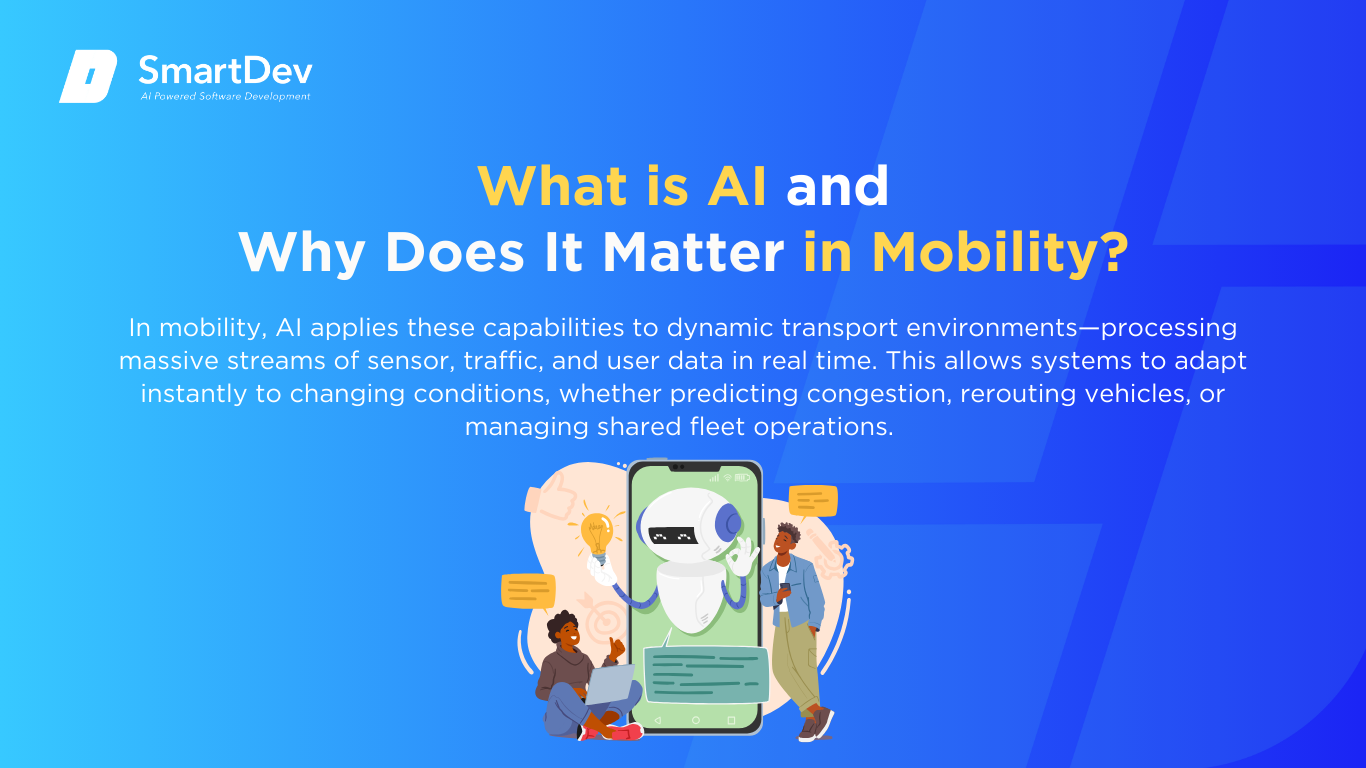 Definition of AI and Its Core Technologies
Definition of AI and Its Core Technologies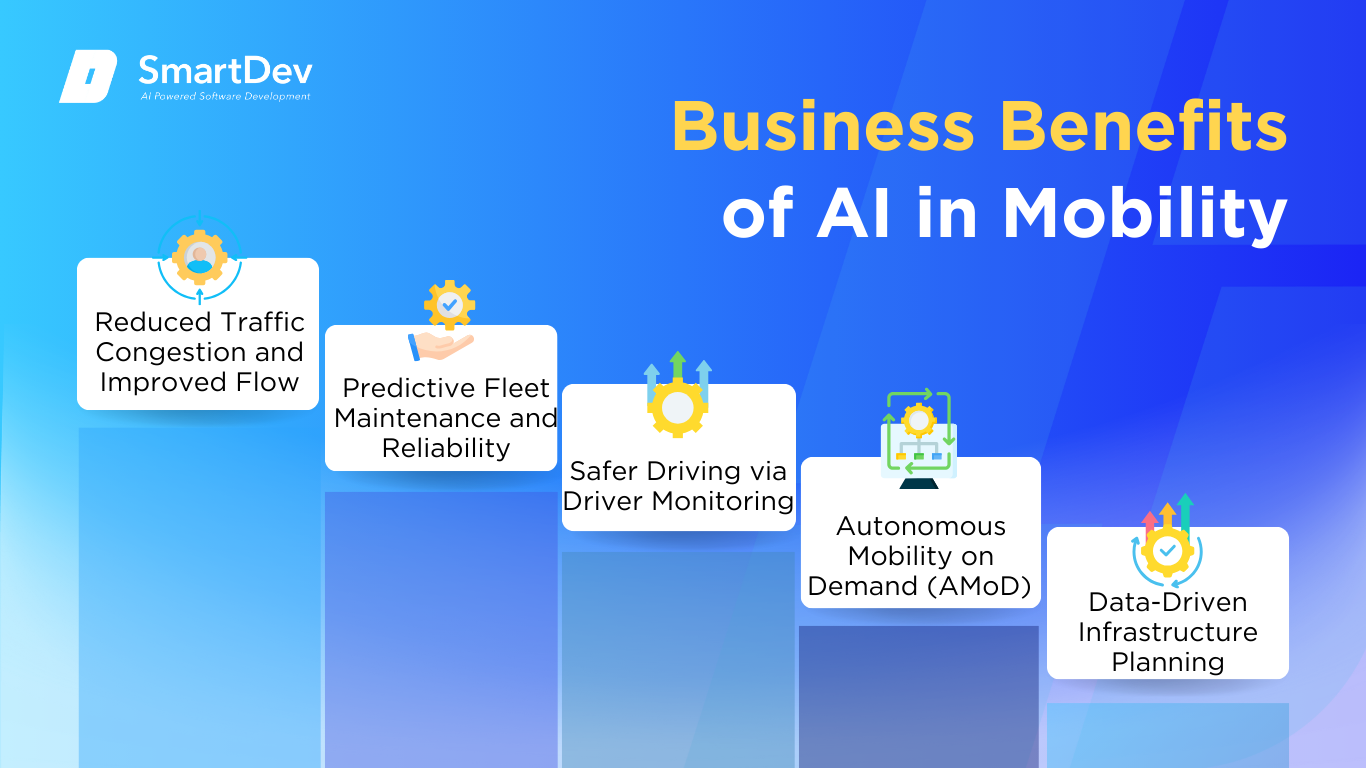
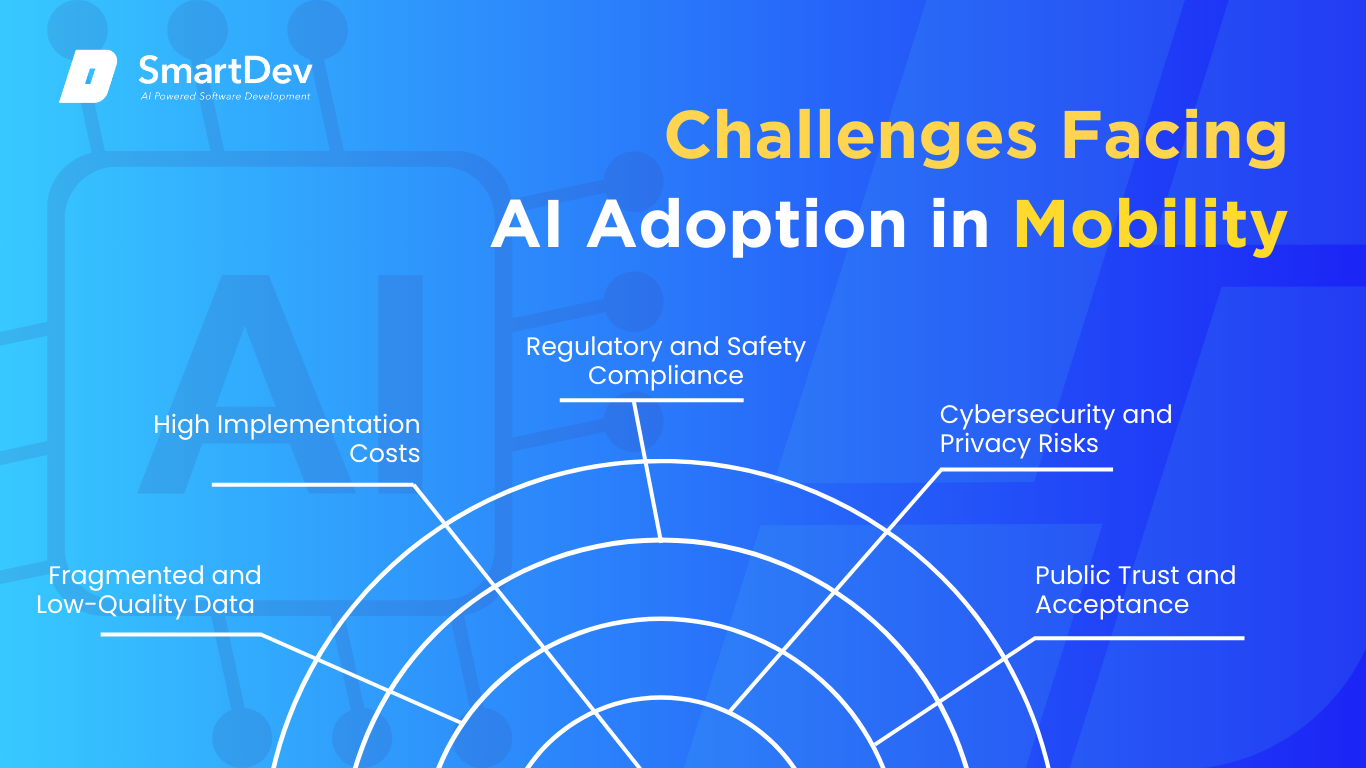
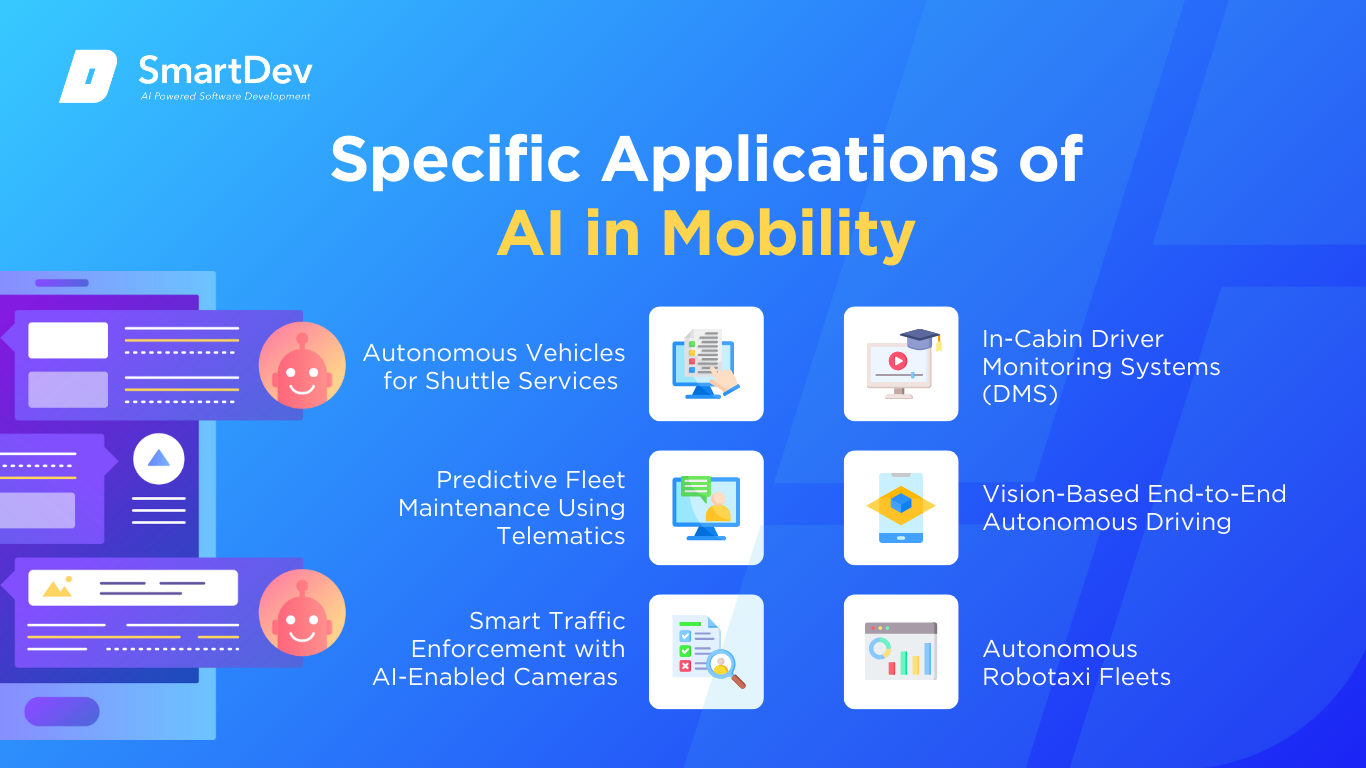 Use case 1. Autonomous Vehicles for Shuttle Services
Use case 1. Autonomous Vehicles for Shuttle Services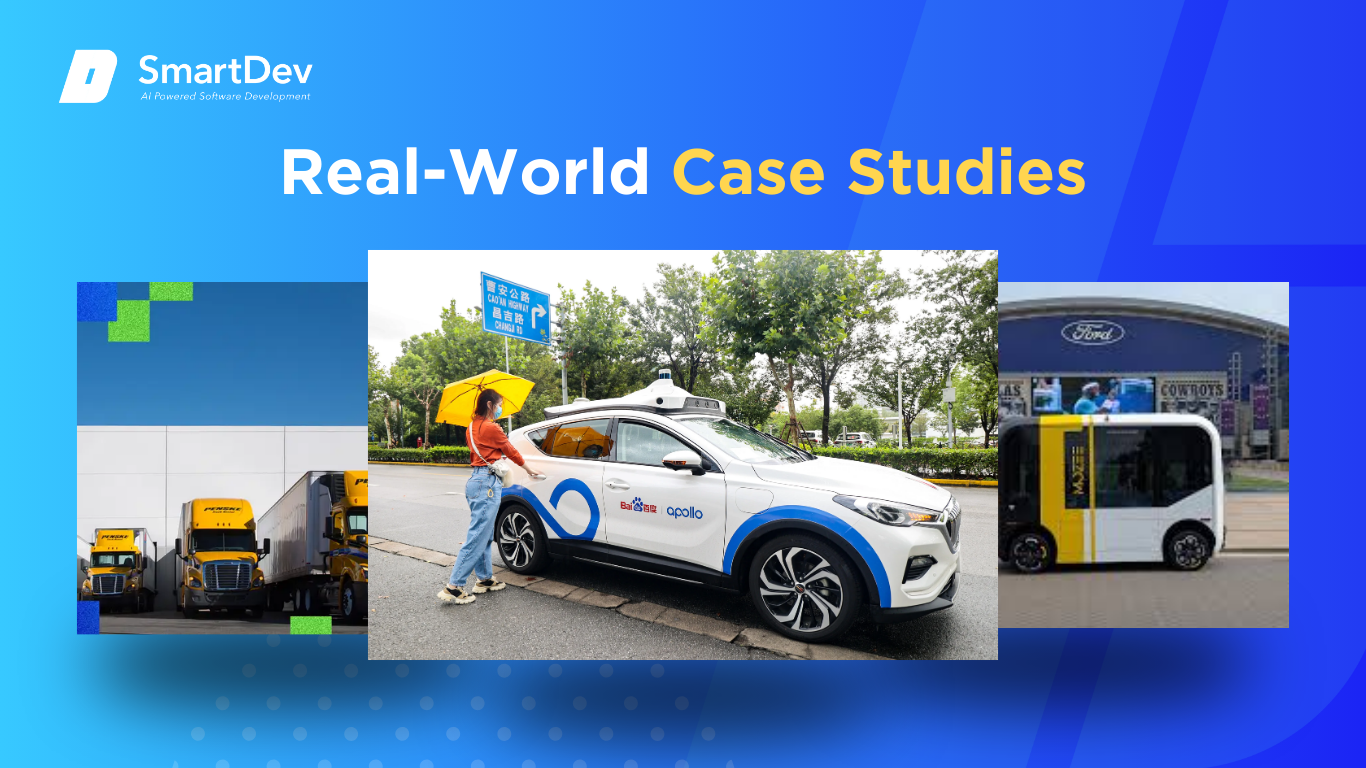 Baidu Apollo Go: Scalable Robotaxi Service
Baidu Apollo Go: Scalable Robotaxi Service 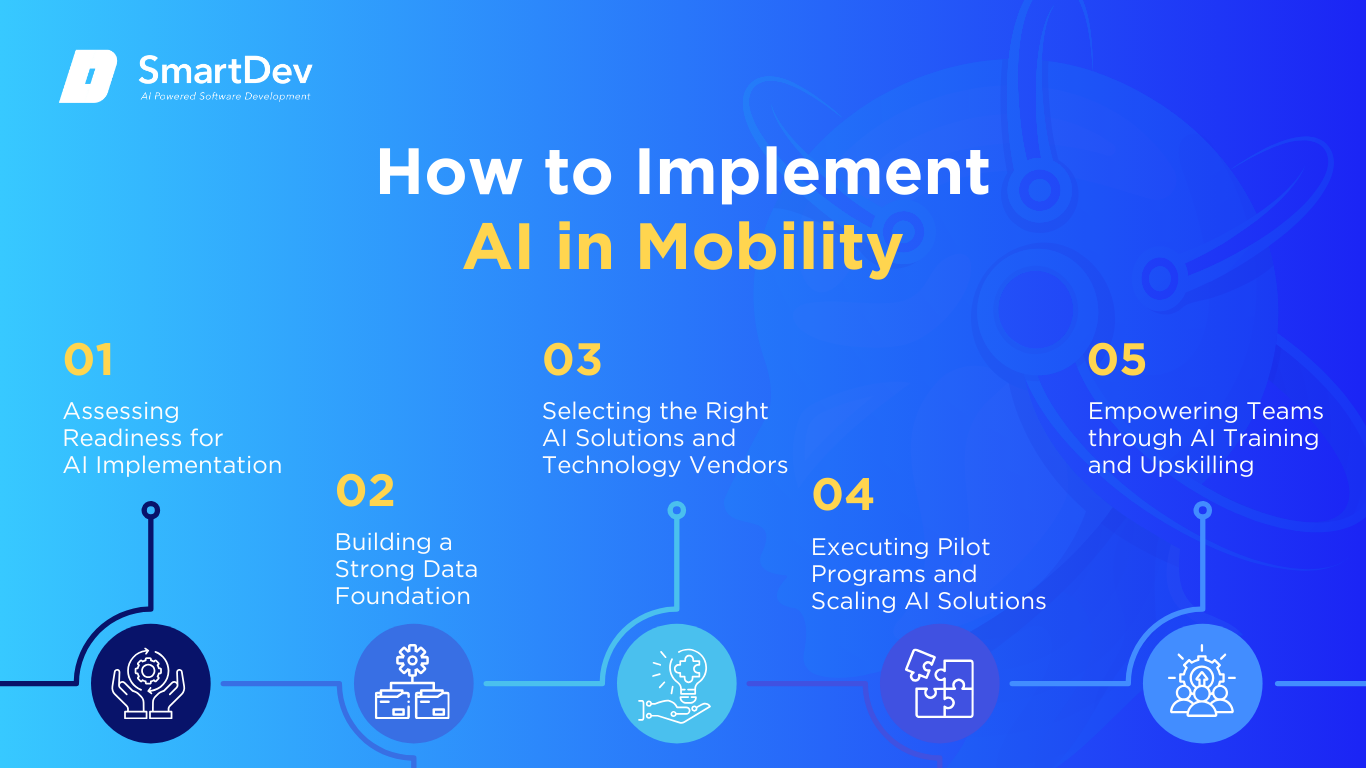 Step 1: Assessing Readiness for AI Adoption
Step 1: Assessing Readiness for AI Adoption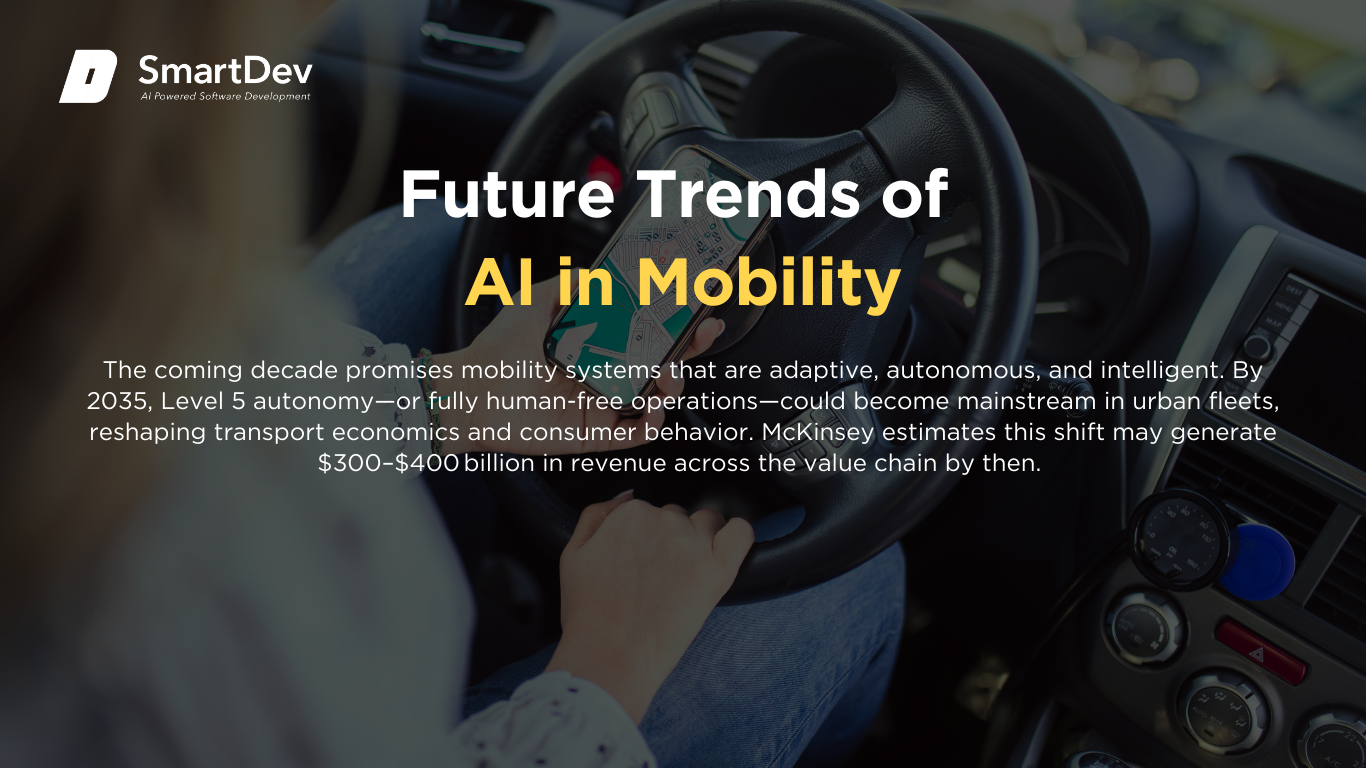 Predictions for the Next Decade
Predictions for the Next Decade
